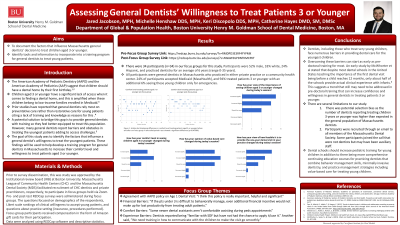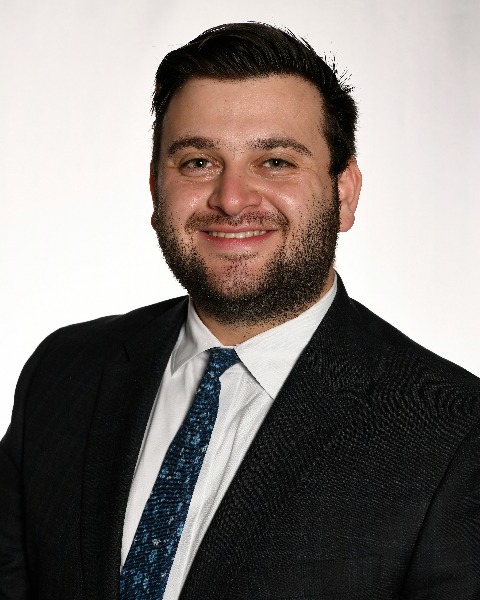Patient Management
551 - Assessing General Dentists’ Willingness to Treat Patients 3 or Younger


Jared S. Jacobson, MPH (he/him/his)
Pre-Doctoral Student
Boston University, Boston, MA
Boston University Henry M. Goldman School of Dental Medicine
Boston, Massachusetts, United States- MH
Michelle Henshaw, DDS, MPH
Boston University Henry M. Goldman School of Dental Medicine
- KD
Keri Discepolo, DDS, MPH
Boston University Henry M. Goldman School of Dental Medicine
- CH
Catherine Hayes, DMD, SM, DMSc
Harvard School of Dental Medicine
- MH
Michelle Henshaw, DDS, MPH
Associate Dean of Global & Population Health; Professor of Health Policy & Health Services Research
Boston University Henry M. Goldman School of Dental Medicine, Boston, MA
Boston, Massachusetts, United States - KD
Keri Discepolo, DDS, MPH
Post Graduate Program Director of Pediatric Dentistry
Boston University Henry M. Goldman School of Dental Medicine
Boston, Massachusetts, United States
Presenting Author(s)
Co-Author(s)
Research Mentor(s)
Program Director(s)
Purpose: This study aims to document the factors that influence Massachusetts general dentists’ decision to treat children aged three and younger.
Methods: Massachusetts League of Community Health Centers (CHC) facilitated recruitment of CHC dentists, and the Massachusetts Dental Society recruited private practitioners to participate in focus groups held via Zoom. Pre and post-test REDCap surveys were administered during focus groups.
Results: Participants were 52% male, 33% white, 24% Hispanic, and practiced dentistry for an average of 6 years (range 0-35 years). 24% of participants accepted Medicaid and 94% treated patients 3 or younger with an additional 6% seeing these young children only for emergencies. Using a 1-10 scale, participants were asked if they feel it is important to see young children and their comfort treating these patients. Average pre-test responses were 7.74 and 6.94 and post-test average values were 7.74 and 7.70, respectively. After a discussion of value-based care (VBC), 65% of respondents’ opinion of VBC increased, 29% stayed the same, and 6% decreased. During the focus group, the main barriers identified to treating young children were inadequate reimbursement, lack of knowledge about minimally invasive treatment and behavior management skills.
Conclusions: Dentists, including those who treat very young children, face numerous barriers in providing dental care for the youngest children. Dental schools should increase pediatric training for young children and more comprehensive continuing education courses for practicing dentists that combine behavior management skills, minimally invasive dentistry, and practice management strategies including VBC for treating young children.
Identify Supporting Agency and Grant Number:
Research supported by CareQuest Institute for Oral Health.

.jpg)